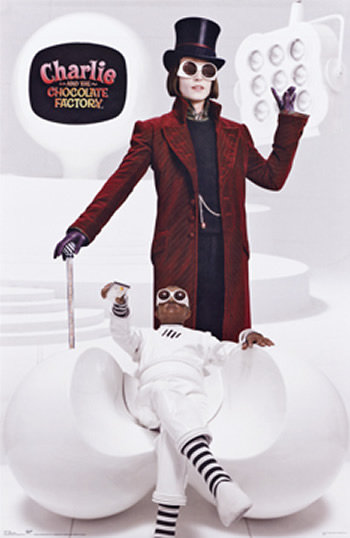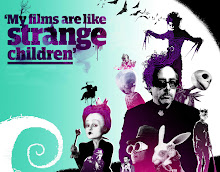"I grew up watching things like The Brain that Wouldn't Die on Saturday afternoon television. There's a guy with his arm ripped off and blood smeared all over the wall…I never saw it as negative. I find that stuff, when it's not rooted in reality, to be cathartic."
Stalk of the Celery Monster (1979) also animator
Luau (1982) co-animator and co-director
Vincent (1982)
Hansel and Gretel (1982)
Frankenweenie (1984)
Aladdin and his Wonderful Lamp (1984)
for the Faerie Tale Theatre television seriesThe Jar (1985)
for the Alfred Hitchcock Presents television series Pee Wee's Big Adventure (1985)
Beetlejuice (1987)
Batman (1989)
Edward Scissorhands (1990)
Conversations with Vincent (1990) Documentary
Batman Returns (1992)
Ed Wood (1994)
Mars Attacks! (1996)
Hollywood Gum (1998) French TV commercial for chewing gum
Sleepy Hollow (1999)
Planet of the Apes (2001)
Big Fish (2003)
Corpse Bride (2005)
Charlie and the Chocolate Factory (2005)
Sweeney Todd (2007) The Demon Barber
Alice in Womderland (2010)
Tuesday, March 9, 2010
Tim Burton
"A lot of things you see as a child remain with you…you spend a lot of your life trying to recapture the experience. "
Monday, March 8, 2010
Tim Burtons early films.
Tim Burtons earliest known film is "The Island of Doctor Agor" which was made in 1971, when Burton was just thirteen years old. It was an animated film shot on Super 8 with a group of his friends. Around the same time, the budding filmmaker also made a short film called Houdini, with himself playing the famous escape artist.
In !979 he decided to make his first “proper” film, a pencil drawn cartoon called "Stalk of the Celery Monster" this film attracted the attention of Disney, who offered the young Burton a job.
Burton apparently never really fitted in at Disney, especially as it existed in the eighties. While working fruitlessly as an animator on "The Fox and the Hound" and "The Black Cauldron,"
Burton spent his spare time indulging his real passion by directing cheapo films such as "Doctor of Doom" (1980) and coming up with ideas for his own personal projects, including what would later become "The Nightmare Before Christmas."
Burton then directed during this time the infamously bizarre film, "Luau" which involved things such as surfing, disembodied alien heads and other weird things. (Clips from the film are available on the A&E biography of Burton) He also came up with the film "Trick or Treat," but we are only offered tantalising hints for those of us who have not seen the film.
"Vincent" was Burton’s first film that actually saw a release, albeit a limited one. A stop-motion animated movie shot in beautiful black and white, it was based on a poem Burton had written himself (1982)
"Frankenweenie" (1984) The film Frankenweenie expanded on many of the classic Burton themes that first surfaced in Vincent. Unfortunately, the film never saw a release at the time. Disney had planned to screen it before a re-release of Pinocchio, but that plan was cancelled when Frankenweenie was given a PG rating, making it “unsuitable” for younger kids. The film was then shelved for about 10 years but praise from people in the film industry who had seen it (which included Stephen King) would eventually lead Burton his first feature film work.
That same year, Shelly Duvall (who had starred in Frankenweenie) asked Burton to direct an episode of her Faerie Tale Theatre series. Burton was chosen to helm "Aladdin and his wonderful lamp" (That episode is now avalible on dvd)
Burton did a respectable job in what was essentially his first “director for hire” role. However, it was not a completely satisfying experience for the director, and he vowed in future to only direct projects he had a personal connection to. His next project was, of course, "Pee-wees Big Adventure."
Burton’s final directing job for TV was an episode of the new Alfred Hitchcock Presents series. The Jar (which aired in 1986) was a memorably creepy story with Griffin Dunne carrying around a sinister head in a jar.
After this, Burton’s feature film career took off and, aside from the odd commercial and web cartoon, he left behind the world of short filmmaking.
Burton’s early films vary wildly, both in production quality and storyline. However, they all have some degree of his fantastical vision stamped on them and are an intriguing portrait of a young director’s developing style.
References:IMDBBurton on Burton by Mark Salisbury (Faber and Faber)Tim Burton by Jim Smith and J Clive Matthews (Virgin Books)Images courtesy of Le Monde de Tim Burton
In !979 he decided to make his first “proper” film, a pencil drawn cartoon called "Stalk of the Celery Monster" this film attracted the attention of Disney, who offered the young Burton a job.
Burton apparently never really fitted in at Disney, especially as it existed in the eighties. While working fruitlessly as an animator on "The Fox and the Hound" and "The Black Cauldron,"
Burton spent his spare time indulging his real passion by directing cheapo films such as "Doctor of Doom" (1980) and coming up with ideas for his own personal projects, including what would later become "The Nightmare Before Christmas."
Burton then directed during this time the infamously bizarre film, "Luau" which involved things such as surfing, disembodied alien heads and other weird things. (Clips from the film are available on the A&E biography of Burton) He also came up with the film "Trick or Treat," but we are only offered tantalising hints for those of us who have not seen the film.
"Vincent" was Burton’s first film that actually saw a release, albeit a limited one. A stop-motion animated movie shot in beautiful black and white, it was based on a poem Burton had written himself (1982)
"Frankenweenie" (1984) The film Frankenweenie expanded on many of the classic Burton themes that first surfaced in Vincent. Unfortunately, the film never saw a release at the time. Disney had planned to screen it before a re-release of Pinocchio, but that plan was cancelled when Frankenweenie was given a PG rating, making it “unsuitable” for younger kids. The film was then shelved for about 10 years but praise from people in the film industry who had seen it (which included Stephen King) would eventually lead Burton his first feature film work.
That same year, Shelly Duvall (who had starred in Frankenweenie) asked Burton to direct an episode of her Faerie Tale Theatre series. Burton was chosen to helm "Aladdin and his wonderful lamp" (That episode is now avalible on dvd)
Burton did a respectable job in what was essentially his first “director for hire” role. However, it was not a completely satisfying experience for the director, and he vowed in future to only direct projects he had a personal connection to. His next project was, of course, "Pee-wees Big Adventure."
Burton’s final directing job for TV was an episode of the new Alfred Hitchcock Presents series. The Jar (which aired in 1986) was a memorably creepy story with Griffin Dunne carrying around a sinister head in a jar.
After this, Burton’s feature film career took off and, aside from the odd commercial and web cartoon, he left behind the world of short filmmaking.
Burton’s early films vary wildly, both in production quality and storyline. However, they all have some degree of his fantastical vision stamped on them and are an intriguing portrait of a young director’s developing style.
References:IMDBBurton on Burton by Mark Salisbury (Faber and Faber)Tim Burton by Jim Smith and J Clive Matthews (Virgin Books)Images courtesy of Le Monde de Tim Burton
Friday, March 5, 2010
Timothy William Burton
The director I have Choosen to study is Timothy William Burton or more commenly known as Tim Burton. Timothy William Burton was born August 25, 1958 in Burbank, California. One of his heroes was actor Vincent Price. Tim was not into reading and was apparently not all that good at school, what he was into was painting drawing and movies.
After high school in 1976, Burton attended the California Institute of the Arts. Cal Arts had been founded by Disney as a "breeding ground" for new animators, though they did offer other courses of study. Burton entered the Disney animation program in his second year, thinking it would be a good way to make a living. In 1979, he was drafted to join the Disney animation ranks.
Burton did not enjoy being an animator, not one little bit. Imagine, if you will, what it's like to be an animator. Films are projected at 24 frames per second. For a 90-minute film, that's over 129,000 individual frames. Characters are drawn separately and then put together, and placed over painted backgrounds. The work requires talented artists, but they cannot deviate from the structured manner of drawing the characters. Burton had been brought in to work on The Fox And The Hound. It bored him silly.
The studio recognized that Burton's talent was not being utilized. They made him a conceptual artist, the people who design the characters that appear in the films. He did early work on The Black Cauldron, the adaptation of the second volume of Lloyd Alexander's Chronicles of Prydain (a seven-volume fantasy series). If you're familiar with Burton's artwork, you can imagine that his concept drawings were nothing like your standard Disney fare. It didn't go over too well, and it was not used. However, he was set loose on his own projects. These included a poem and artwork that years later would become The Nightmare Before Christmas, the animated short Vincent, and the live-action short Frankenweenie.
(source http://www.timburtoncollective.com/bio.html )
After high school in 1976, Burton attended the California Institute of the Arts. Cal Arts had been founded by Disney as a "breeding ground" for new animators, though they did offer other courses of study. Burton entered the Disney animation program in his second year, thinking it would be a good way to make a living. In 1979, he was drafted to join the Disney animation ranks.
Burton did not enjoy being an animator, not one little bit. Imagine, if you will, what it's like to be an animator. Films are projected at 24 frames per second. For a 90-minute film, that's over 129,000 individual frames. Characters are drawn separately and then put together, and placed over painted backgrounds. The work requires talented artists, but they cannot deviate from the structured manner of drawing the characters. Burton had been brought in to work on The Fox And The Hound. It bored him silly.
The studio recognized that Burton's talent was not being utilized. They made him a conceptual artist, the people who design the characters that appear in the films. He did early work on The Black Cauldron, the adaptation of the second volume of Lloyd Alexander's Chronicles of Prydain (a seven-volume fantasy series). If you're familiar with Burton's artwork, you can imagine that his concept drawings were nothing like your standard Disney fare. It didn't go over too well, and it was not used. However, he was set loose on his own projects. These included a poem and artwork that years later would become The Nightmare Before Christmas, the animated short Vincent, and the live-action short Frankenweenie.
(source http://www.timburtoncollective.com/bio.html )
Subscribe to:
Posts (Atom)








